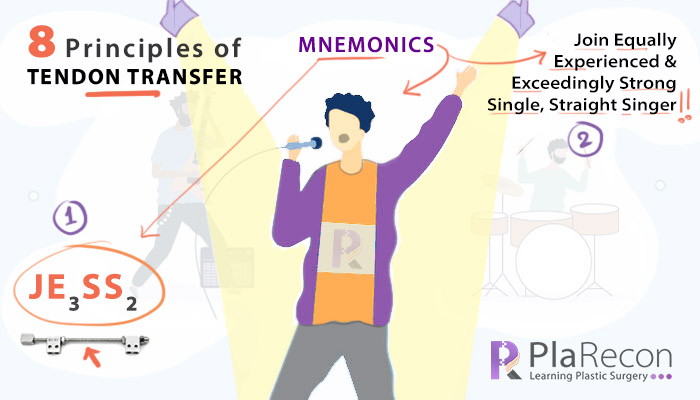There are 8 essential principles or pre-requisites of tendon transfers for various nerve palsies or for replacing functions of tendons lost to trauma or oncoplastic excision and reconstruction.
The first 3 principles are related to the Recipient site while the rest 6 are regarding the Donor tendon. 💡
💡 Mnemonic: J E3 SS2
→ Most Plastic surgeons esp. in India are aware of Dr Joshi’s external stabilizing system (JESS) or JESS fixator. Here, it serves as a mnemonic for the ‘principles of tendon transfers’. [Note: SS2 implies 4S.]

For further aid to memory, here’s another silly but useful 💡 Mnemonic →
Join Equally Experienced & Exceedingly Strong, Single, Straight Singer
Each word respectively stands for → Joints Equilibrium Expendable Excursion Strength Single Straight Synergistic → from which the 8 principles can be deduced, in order.
1. Joints- supple
Joints, especially the metacarpophalangeal joints in the case of hand, should be supple with full passive ROM (Range Of Motion). Joint stiffness should be addressed by aggressive therapy before any tendon transfer is attempted. If contractures are present, should be released earlier.
Note: Normal sensations distally- that is not always present in practical circumstances.
2. Equilibrium of soft tissue
The transferred tendons should lie in a healthy bed of tissue with no edema, inflammation, or scarring. If the bed is scarred, it should be excised and covered with a flap earlier.
3. Expendable
For every tendon transferred, there must be at least one other muscle that could continue to perform the function of the transferred tendon.
Eg. Wrist extension is done by three muscles- ECU, ECRB, ECRL of which any two can be used for tendon transfer.
4. Excursion of tendon
The excursion or ‘amplitude of motion‘ of the donor tendon should be similar to the tendon being replaced. Excursion for:
- Wrist flexors, extensors = 3cm
- Finger flexors = 5cm
- Finger extensors = 7cm
💡 Mnemonic: Proximal to distal (wrist to fingers), Flexor to extensor: 3, 5, 7 (odd numbers).
5. Strength- adequate
The strength or ‘power‘ of the donor muscle should be relatively comparable to the usual power of the muscle whose function is to be restored. The transferred muscle should not be stronger (antagonistic function gets restricted) or weaker (not effective).
Note: Muscles usually lose at least 1-grade power following transfer.
The relative strength of:
- BR, FCU → 2
- FCR, Wrist extensors (ECU, ECRB, ECRL), PT → 1
- Finger extensors (EDC, EI, EDM) → 0.5
- APL, EPL, EPB, PL → 0.1
6. Single Function
One tendon, One function
For the most effective transfer, one tendon should be designed to replace a single function. Eg. Replaced extensors of fingers could also cause wrist extension (by ‘tenodesis effect‘) but the power of both the functions would be compromised and both wouldn’t be possible simultaneously.
7. Synergistic muscles
Synergistic muscles are those which act together to produce a single composite movement. They should be used to replace each other preferably.
Eg.
- Finger flexors ↔ Wrist extensors
- Finger extensors ↔ Wrist flexors
8. Straight line
To be most effective, the tendon being transferred has to traverse from its origin to its new insertion in a straight line.
To achieve this, the muscle might have to be dissected free- till close to its origin (taking care not to injure the main nerves and vessels supplying it). The plane where it lies (above or below surrounding muscles) may also need to be changed.
We should aim to follow all these 8 basic principles for every tendon transferred. However, in certain specific circumstances, one or two of them may get compromised- like principle no. 6 in case of paucity of donor muscles and principle no. 8 in transfers where pulley action is required.
If you found this post useful subscribe below for more such articles & subscribe to our YouTube channel for video tutorials. You can also find us on Facebook, Twitter and Instagram.

Tutorials & tips in Plastic Surgery
+ Weekly updates of high-quality webinars!




A popular Mnemonic for the 6 Donor tendon principles is “APOSLE”.
It somehow didn’t work for me and that led to the ones mentioned in the post above.
If you have some other mnemonics or interesting points, please feel free to share here.
Join equally experienced exceedingly strong single straight synergistic surgeons in to a group